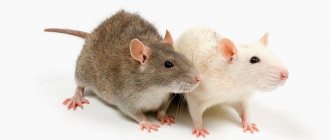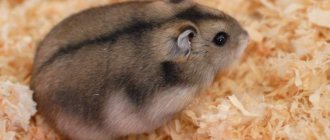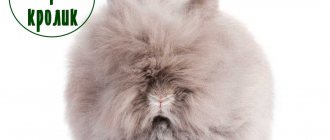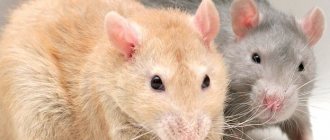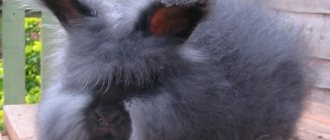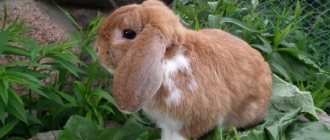- home
- Acquisition
15.04.2018
Many people choose various rodents as pets. This is not surprising, because they take up little space and are easy to care for. Such pets are often given to children, so parents have a question: who is better, a hamster or a rat, should they take a guinea pig or a rabbit. There is no clear answer. Each animal is different from each other in its own way.
Rabbit or chinchilla.
Who do you recommend - a chinchilla or a rabbit? And why? What to look for when choosing an animal? Who has at least one of these cute creatures? Who is more difficult to care for? Or just why did you choose him?)) I would be grateful to all the experts who responded, since there have never been such animals) There were only dogs, cats, parrots, fish)))
Published January 31, 2022, 6:11 pm
Did you know that the Sperm Whale auction helps you save money? Try it.
I'm for the chinchilla. Both in terms of intelligence and in terms of smell
Neither am I for them)) we had a chanchilla Bonya.
There was no smell at all during timely cleaning. Not fussy about food.
It seems to me that a rabbit is easier to care for and unpretentious in food. A friend of mine had a couple of chinchillas, he raised them for his wife’s fur coat))) so the food is special, and they are very gentle, they didn’t live long with him
For my wife's fur coat. poor things(((They seem to eat feed and hay. They probably get sick often
We have a Rabbit - I hold it in my arms, but not for long. Of the rabbits, it is better to take a boy, they say girls are more aggressive. He often asks to eat at night. We let him out to run, but I make sure there’s nothing wrong with the grizz. Before the rabbit, the guinea pig lay nearby and the children carried it in their arms. And more vegetables and fruits are allowed than for rabbits. My sister has 2 chinchillas, but it’s hard to hold in her arms.
Chinchillas also run and lay there somewhere.
Shush can be trained not to shit anywhere.
I scold the rabbit and poke it with its nose. It happens occasionally) As you train it.
We had a rabbit, as soon as I remember, I’ll shudder (((Until 6 months everything was ok, then puberty started and he became sooooo aggressive ((( bit the child’s leg, wouldn’t go into his arms anymore, hissed at everyone, chewed corners, wires and hoses from the washing machine.
It’s a pity to keep a chinchilla in a cage(((, I saw it with friends((if there is a lot of private house and space, then yes, you can make it like an enclosure, otherwise it looks like abuse of an animal(((
If the cage is spacious and high, then everything is fine.
No one. Better already a cat. Krol lived for 8 years. At first it was normal. But old age, as they say, is not joy((((hay everywhere, cleaning the cage every day. Then he began to walk under himself, everything is always wet((((smell accordingly ((( Chinchilla is the same + sand everywhere.
I put the sand in the cage, just like it was bought, then I remove it.
The chinchilla is very noisy at night, he needs a separate room. He chews everything, wires, wallpaper, doors, you need to be careful when you let him out.
I agree, at night it makes noise and can scream, well, mine screams sometimes. Lives in the kitchen
Chinchilla is a nocturnal animal! And the rabbit is daytime! The difference is in square meters!
Maybe off topic, but I'm for the rat. Smart, playful, omnivorous
FISH! A little over a year ago, we also really wanted to please the child and buy an animal. I also had my doubts about a rabbit or a chinchilla for a long time. I read a bunch of forums, thought and decided for a long time. The chinchilla was discarded after we found information that they can hardly stand the heat, 25 is already too much for them, and in our apartment with the radiators turned off in the winter, only in severe frosts does it get less than 25. And in the summer, with open windows to the north-west, it is still hot, the windows are all on one side. In general, we decided on a rabbit. I will never own another animal again. This cute animal touched us for the first month. And then, during its walks, it began to gnaw on everything it could reach, including us (you’re sitting at the laptop, not touching anyone, but it comes up from behind and gnaws at the back of your neck! - do you know how painful it is?), wallpaper everywhere, all the cords, everything that was wrong lay there. And yet, yes, the house is cleaned every day, there is a lot of shit per day, it stinks despite all the stuff in the pot. Moreover, it is better to place the pot so that he sits on it when he eats - because there is a rectum there - as soon as he eats, he immediately puts it on. Although there is quite a lot besides the pot. In general, we gave her (she was a girl) to a private home; our three-ruble ruble was not enough for her. Take the advice of experienced people, get some fish))))
“And under this guise he was hiding...”
A year ago, a work colleague encountered deception and for a long time had to “scrape out” money for a fur coat that was returned to the store. Despite the fact that the truth was on her side: the owner of the salon deliberately misled her, fortunately, the words “beaver” and “beaver” have the same root.
We must pay tribute: the fur coat was beautiful - light silver, fitted silhouette and comfortable length (just below the knee), with bell sleeves and a voluminous hood. It gently “flowed” over the figure, “enveloping” the owner of the fur coat with warmth and comfort. But this does not mean that it could be sold for fabulous money!
The “beaver” turned out to be not a waterfowl with the strongest and most durable fur, the beaver, but a Rex rabbit with a beaver-like skin. Plush, velvet, velor - that’s how you want to name these animals and stroke their soft, even fur, how attractive they are!
The history of these living soft toys began in France, at the beginning of the twentieth century, when a rabbit with an unusual fur texture was presented at one of the exhibitions. He was named "Rex", which translated from Latin means "king, king". The breed was obtained as a result of long-term selection of representatives of domestic (the Belgian giant breed, which is the size of an average dog) and wild rabbits.
A mutation in one of the genes in the body of rex rabbits causes the hair to grow not at an angle, but vertically: while the main and guard hairs remain the same length (about 2 cm). That is why the fur turns out smooth - without “transitions” from short undercoat to long hair. Rex can have more than a dozen different colors - white, black, lilac, chocolate, speckled, agouti (interesting shades - as if shaded, “camouflage”: they originate from predator hunters in nature).
Yellow-bellied marmot - why not a beaver?
Now breeders have developed several variants of rex, which are very similar in appearance to the fur of valuable fur-bearing animals. For example, castor rex: translated as “king of the beavers” (French castor from the Greek kastor - beaver). The rabbit looks very much like our Red Book beaver, deep chestnut color with a beautiful chocolate tint. For information, castor is also called dense pile cloth made from yarn with the addition of beaver or goat down.
The “King of Martens” is the Marder Rex breed - almost a copy of the durable, expensive fur of mammals from the mustelidae family. Skins from real martens and sables were previously called “soft gold”, which was used to pay for goods, considered the hardest currency.
This is not a chinchilla rex, but a real chinchilla.
Another premium type of Rex rabbit is the chinchilla. It practically does not differ in color from its high-mountain rodent “doubles”. Fur coats, capes, and blankets made from such fur look original, almost “luxury.”
Rabbit & chinchilla: choosing a pet
“Which should I get, a rabbit or a chinchilla?” This question is often asked by people who want to get a new pet. To help you make your choice, let’s now compare these charming fluffies according to the most basic parameters.
Smell and tray
The main factors of interest to a person planning to get a pet. Chinchilla doesn't smell. In the cage he chooses one corner for the toilet, washing which completely eliminates unpleasant odors from feces. When moving around the apartment, he can shit anywhere. There is a smell from the rabbit. The tray and cage will have to be washed regularly, sometimes 2 times a day. But the rabbit easily gets used to the tray, into which it runs while walking around the room.
Health and hygiene
Both rabbits and chinchillas react poorly to drafts and temperature changes, as well as loud, sharp sounds and smells. The rabbit needs to be regularly bathed, combed, and its claws trimmed. The chinchilla bathes in special sand in a special bath; no other care for its coat is required. If a rabbit gets sick, it is easier to cure - veterinarians deal with them tens of times more often than with chinchillas. In addition, there are vaccines for rabbits that help avoid many diseases.
Character and behavior
It is difficult to hold and pet a chinchilla. But unlike the affectionate rabbit in this regard, she will not become aggressive during puberty and hunting. The rabbit can be carried in your arms, stroked and scratched, the big-eared one will be delighted with this. Willingly take part in children's games and make friends with a cat or dog. Until he grows up, he will be sweet and affectionate. And then an increase in aggression is possible: the rabbit will attack, scratch, bite. The changes in the behavior of female rabbits become especially sharp.
Diet
Both species are considered problem-free in nutrition. Grass, hay, grain mixtures, fruits and berries - the animals’ diet is almost identical. There are no sharp differences in one direction or another.
Ease of maintenance and walking around the apartment
Both animal species require cages. An inexpensive standard cage is suitable for a rabbit, but a chinchilla cage requires a special one and is not cheap. Given nighttime activity, the cages are located away from the bedrooms. And while a rabbit can be trained not to make noise at night, this trick won’t work with a chinchilla. The cute creature puts on such nightly concerts that there may be complaints from neighbors. The disadvantages of a rabbit include peeled wallpaper, chewed wires, damaged furniture, and smelly urine marks. Although the chinchilla does not refuse the opportunity to sink its teeth into everything that catches its eye. In addition, it easily squeezes into the narrowest cracks, which can lead to unpredictable results.
Let's summarize: If you have the opportunity to devote a lot of free time to an animal, a rabbit is suitable for you. You can play with it and walk with it, taking it out on a harness, the rabbit can be trained - the animal easily masters simple tricks. If the absence of odor and a minimum of fuss with cleaning the cage are more important to you, get a chinchilla. Watching the jumps and games is also a pleasant pleasure. But all her walks around the apartment must be under strict control.
Subscribe
to our channel and read new articles, blogs and topics daily.
Our VKontakte and Facebook pages. There are also a lot of interesting things there!
Some images on our channel are taken from open sources, Yandex Images and social networks.
Source
Homemade "toy"
Rex
They are bred not only to obtain beautiful skins, but also as “couch” pets. They are friendly, easy-going and get along well with people and other animals. There are special decorative dwarf species that are easy to accustom to the litter box and other objects of “cat” civilization. You just need to take into account that cozy soft “toys” make good jumpers (up to a meter high) and rodents that, in addition to carrots, are not averse to testing electrical wires and cables.
Rex
They feel good in our harsh climate; they can be housed in cages right on the street, under a canopy. In summer, it protects fur animals from overheating (air temperatures above 25 degrees are poorly tolerated by them). Only newborn rabbits (which look very similar to squirrels) require more thorough, warm rooms. Rexes, unfortunately, do not produce large offspring (usually no more than 7), but they are valued quite highly on the market. Babies are put up for sale and purchased when they are 1 month old, and it is important that the animals do not have drooping ears or matted fur - signs of a defect in the breed.
The cage is made of durable material that cannot be chewed, the bottom is mesh with bedding on top. They carefully monitor cleanliness to prevent the spread of infections and parasites. Animals should always have clean water in their drinking bowls (heated in cold weather), and hay should not fall out of the feeder (royal rabbits do not eat from the floor).
Rabbits of this breed eat in small portions, but often: it is better to distribute food at strictly defined hours (for adults - 3 times, for babies and mother rabbits - 4 times a day), so that gastric juice is actively produced and the food is well absorbed. For healthy digestion, approximately 2/3 of the diet should consist of foods containing fiber - hay and green succulent food.
It is important to provide a varied diet. The menu is based on grain concentrates, especially from oats and corn with the addition of cake and bran. Oats can be given dry, and corn grain can be crushed and slightly soaked in water until soft. The female rabbit and her offspring must cook barley, oats and legumes after grinding; goat’s milk is also beneficial for the family.
Concentrates can replace special feed for rabbits; sometimes, in force majeure circumstances, an option intended for pigs or calves is allowed, but not for birds (due to the presence of shells and small stones in it).
A significant part of the “velvet hares” diet is given to green food (from spring to autumn), which can be prepared in the garden, as well as in the forest, field, and meadow. They will go into action:
- fodder cabbage, tops of fodder beet, turnip, rutabaga, Jerusalem artichoke, sugar beet and rhubarb;
- herbs clover, alfalfa, nettle, burdock and dandelion.
In winter, when there is no greenfinch, vegetables and root vegetables are actively fed: carrots, potatoes, beets, zucchini, pumpkin (good boiled), turnips, and apples. Rabbits also need hay, branches, and sometimes straw. Vitamin-rich twigs of juniper, spruce, pine, rowan, linden, birch and apple trees are prepared for future use.
Keep in mind that edible plant foods may accidentally contain harmful ingredients: tops of tomatoes and potatoes, branches of cherries, cherries, plums (contain hydrocyanic acid), poisonous branches of wild rosemary, buckthorn, apricot, elderberry and bird cherry. The prohibited list also includes henbane, buttercup, lily of the valley, spurge, night blindness, fern, and datura.
It can be difficult to balance such a variety of feeds on your own; pets may experience a lack of certain vitamins and microelements. Often rabbits begin to go bald and pluck each other's fur. To ensure that animals are provided with the full range of necessary nutrients, use a specially created premix -
"Health for rabbits." It contains a complex of vitamins - A, B1, B2, B3, B4, B5, B12, C, D3, E, biotin; list of important macro- and microelements. With the supplement, animals' appetite and vitality improve, and the incidence of illness decreases. The weight increases, the coat becomes dense, dense and durable.
Rabbit or chinchilla?
Rabbit or chinchilla?
Unread message by kora » 03 Mar 2013, 23:45
Re: Rabbit or chinchilla?
a couple tells me that if an animal is gray in a cage, then the stench will be unmistakable and it doesn’t matter who is in the cage, especially since he’s been at work all day
I think rabbits are more susceptible to careful grooming, they die in vain, God forbid there is a draft, vaccinations are required
As for chinchillas, I don’t know anything about them, I just saw that they are expensive and infectious
Re: Rabbit or chinchilla?
Re: Rabbit or chinchilla?
Unread message NFO » 04 Mar 2013, 05:26
Re: Rabbit or chinchilla?
Re: Rabbit or chinchilla?
Decorative rabbit - character depends on the breed (Similar to dogs/cats). Personally, I give my preference to dwarf fold-eared rams - although they have slightly greater parameters than other dwarf ones (I can advise where to get a baby rabbit from medium-sized parents - 1200-1400 with a soft character), but the character is sociable, not harmful. Contact dogs are well accustomed to order (toilet and other hygienic procedures and the need to chew on anything/wherever), they know their name and are very affectionate. I have never observed males of this breed marking territory - a huge plus. Active during the day, activity at night is rather an exception. Often kept without cages (As a small rabbit grows up, it must be kept in a cage). They are unpretentious when it comes to food, but they have their own nuances. There is no need to walk the streets - accordingly, the risks of contracting an infection are minimal. They only suffer from their own (rabbit) diseases (with the exception of skin diseases). In general, in terms of maintenance and care, they are in many ways similar to cats/dogs.
Chinchilla. Independent and hyper-active. Night animal. Letting him go for a walk requires constant monitoring - it will not be possible to wean him from gnawing and sharpening the necessary things and furniture. A very cute and funny animal. Contact with water is strictly prohibited (drinking only, in automatic drinkers), they bathe in special sand, do not give wet food, and are fed only with special feed mixtures. Walking outside is also not necessary; a cage is required and a tall, multi-tiered one is desirable.
The excrement of decorative rabbits and chinchillas does not have a distinct odor, and the wool also does not have any specific odors. The starting costs for a chinchilla are several times higher, but further maintenance costs are approximately the same. Neither chinchilla nor rabbit requires pairs. To make a choice about who you need, you first need to decide what you want to get from the animal? And buy a young animal.
Source
The nuances of keeping other rodents
Mice and rabbits are kept less frequently; chinchillas are considered decorative pets. Is it worth having them at home?
- Mouse.
In appearance and character it resembles a rat, the differences between them are insignificant. About the same as a Djungarian hamster. A small mouse does not cause such fear as a large rat. Repels unpleasant odor. But if you watch the animals running around the cage and playing, a positive mood for the whole day is guaranteed.
- Chinchilla.
A larger animal than a hamster. The chinchilla should live in a large, spacious enclosure. This animal requires a lot of attention. The child will not be able to care for her on his own. Therefore, if you get this exotic animal, be prepared to maintain it yourself. An animal requires a lot of expenses to purchase and care for. Life expectancy is long, from 10 to 15 years. It's up to you to decide who is better, a hamster or a chinchilla. Not everyone can care for a pet for 15 years.
- Decorative rabbits.
Rabbits live 10-12 years, they are friendly and do not bite. But they need to run around the apartment, which threatens to chew through the wires. A rabbit requires more care and time. He is susceptible to disease, his health needs to be monitored. Rabbit or hamster, decide for yourself, depending on your preferences.
- Guinea pigs.
If you don't want to get a hamster, opt for a guinea pig. These friendly creatures are easy to tame. You can take two individuals at once, they will easily get along in one cage. Pigs are less clean and make more noise.
Guinea pig, rabbit or chinchilla?
There comes a time in every family when growing children want to have a pet. Choosing an animal is not an easy task, especially when parents do not have time to walk it, and the child himself cannot yet fully take on the responsibilities of maintaining a pet.
The solution is to buy a small rodent. He lives in a cage, can go for walks right in the apartment, and spending the day alone is not a big problem for him.
Each animal has its own advantages and disadvantages. Knowing them will help you make the right choice.
Rabbit
Many people like kittens, but they are often allergic to them, and therefore a tiny rabbit can be an alternative - representatives of decorative breeds can easily fit in the palm of your hand and weigh around one and a half kilograms. And you can really play with it: rabbits are very mobile, and therefore need daily walks around the room.



